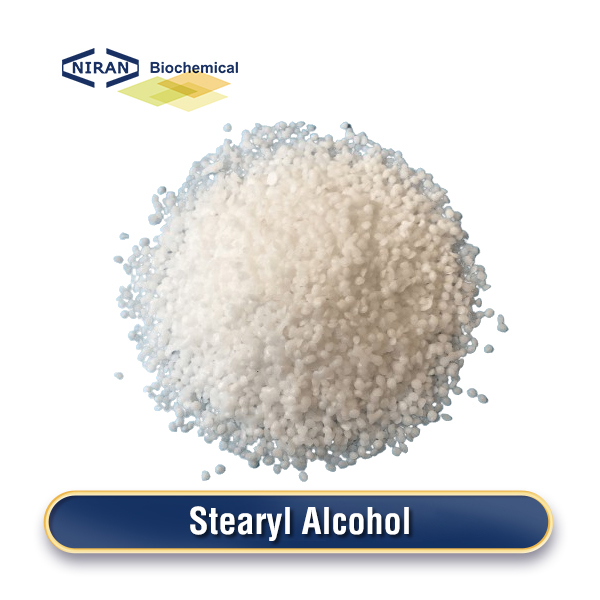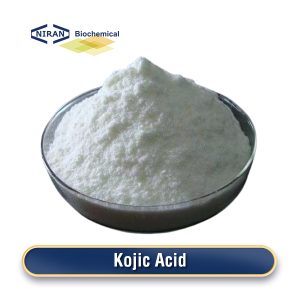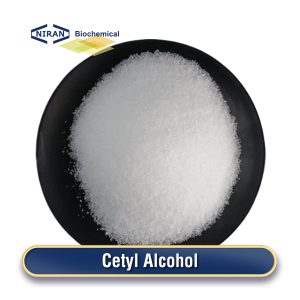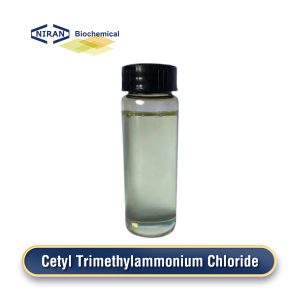Stearyl Alcohol
- CAS Number: 299-29-6
- Chemical Formula: C18H38O
- MOQ: 1000KG
- Shelf Life: 2 years
- Forms: Crystal
- Synonyms: Stearyl Alcohol, 1-Octadecanol, Octadecyl Alcohol, Stearyl Hydroxide
Product Description
What Is Stearyl Alcohol?
Stearyl Alcohol is a waxy, white solid used as an emulsifier, thickener, and emollient in cosmetics, pharmaceuticals, and industrial applications. It enhances texture, moisture retention, and stability in lotions, creams, and conditioners.
Preparation Method:
The main process for making stearyl alcohol is hydrogenating stearic acid or its esters. The process involves: Hydrogenation: Stearic acid or methyl stearate reacts with hydrogen in the presence of a metal catalyst (e.g., nickel) under high temperature and pressure. Purification: To produce high-purity stearyl alcohol, the crude product is purified by distillation or crystallization.
Related Parameters:
| Items | Standards |
| Appearance 30℃ | White crystal |
| Colour Hazen | 10max |
| Moisture % | 0.15max |
| Acid Value mgKOH/g | 0.2max |
| Saponification Value mgKOH/g | 0.8max |
| Iodine Value gl2/100g | 0.8max |
| Melting point ℃ | 55-61 |
| Hydroxyl Value mgKOH/g | 200-220 |
| Total Alcohol % | 99.0min |
| Hydrocarbon alkyl % | 1.0max |
| C18 Alcohol % | 98.5min |
Recommended Dosage of
Stearyl Alcohol:
| Applications | Dosage |
| Cosmetics and Personal Care | 2%-4% |
| Hair Care Products | 1%-3% |
| Pharmaceuticals | 1%-3% |
| Emulsions (Cosmetic/Pharma) | 2%-4% |
| Industrial Applications | 0.5%-3% |
| Surfactants | 1%-2% |
| Plasticizers | 0.5%-1% |
| Food Industry (limited use) | <0.1% |
| Aromatherapy (Carrier Oils) | 1%-2% |
Stearyl Alcohol Has Wide Range of Uses:
Hair Care: It is incorporated into conditioners and shampoos to condition, detangle, and smooth the hair.
Pharmaceuticals: Acts as an emulsifying agent in ointments, creams, and gels.
Industrial Applications: Employed in lubricants, plasticizers, and coatings to enhance flexibility and durability.
Surfactants: Used as emulsifiers and surfactants in cleaning products.
Plasticizers: Improves flexibility in plastics and rubber products.
Food Industry: Used in processed foods as an emulsifier on occasion (restricted use).
Aromatherapy: Functions as a carrier oil for essential oils.
User Asked Question:
Q: What is the difference between Octadecanol (Stearyl Alcohol) and Hexadecanol (Cetyl Alcohol)?
A: The primary difference between Octadecanol (Stearyl Alcohol) and Hexadecanol (Cetyl Alcohol) lies in the carbon chain length. Octadecanol has 18 carbon atoms (C18), while Hexadecanol has 16 carbon atoms (C16). This difference in chain length results in Octadecanol having a higher melting point, making it more waxy and heavier at room temperature. Consequently, Octadecanol is often used in thicker formulations like creams and lotions, while Hexadecanol, with its shorter chain, is more commonly used in lighter, smoother products such as emulsions and hair care items.




